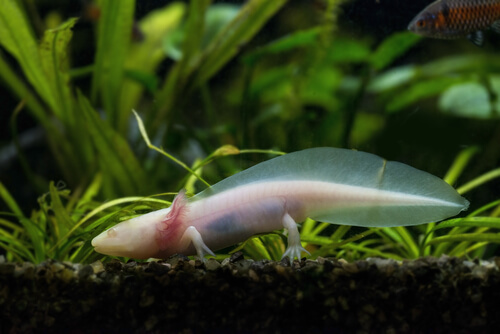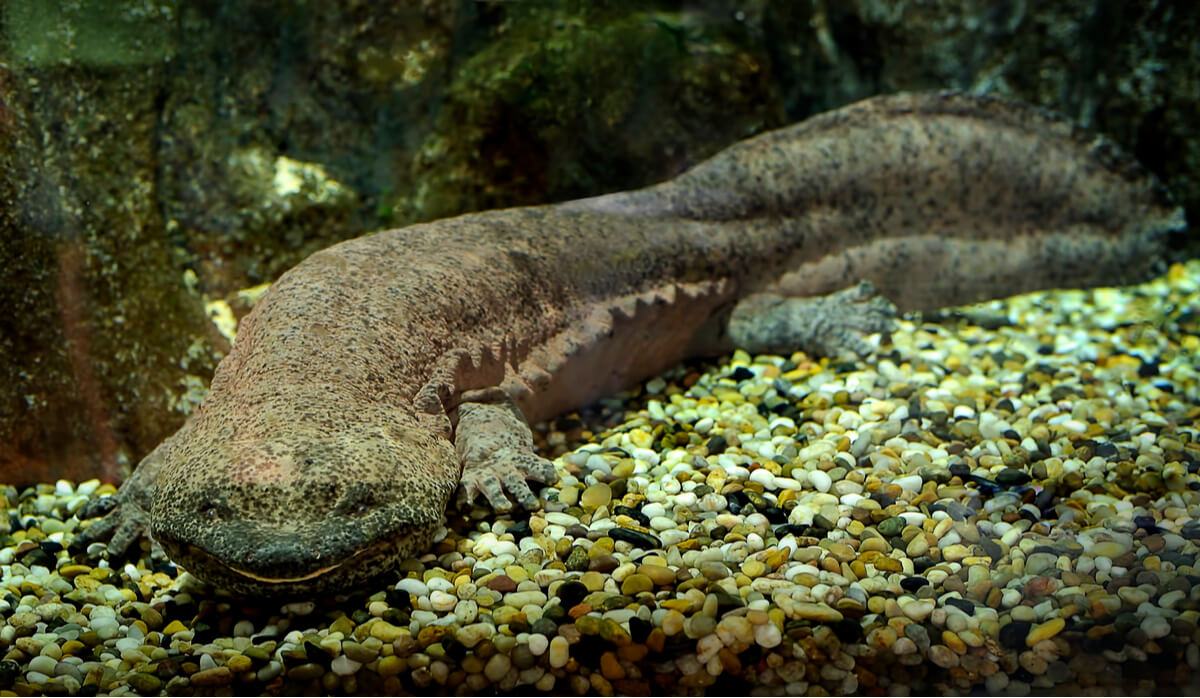9 Curiosities About Salamanders

Salamanders are a particular type of amphibians that closely resemble lizards, but with the characteristic moist skin that distinguishes these animals. Most of these animals are nocturnal and inhabit places with good water availability. In addition to having a peculiar appearance, several salamanders have secrets and interesting curiosities.
Formally, the term “salamander” is used to identify members of the order Caudata. This taxonomic group is a close relative of the Anurans, which includes toads and frogs. Read on and discover some interesting facts about salamanders.
Curiosities about salamanders
There are more than 660 known species of salamanders, each with distinctive and unique characteristics. Although some of them seem simple and inconspicuous, all of them hold secrets little known to people. Learn some of their curiosities below.
1. They have different ways of breathing
Usually, the amphibian group is characterized by having gills in their early stages of life and lungs in their adult stage. However, salamanders break this rule, as some species retain their gills and don’t develop lungs. Thanks to this, they can have at least three breathing options: breathing through gills, breathing through lungs, or breathing through the skin.

2. The first salamanders lived alongside the first dinosaurs
The salamander group is one of the oldest. In fact, Triassurus sixtelae species is the oldest known member. This extinct creature lived during the Upper Triassic, so it was contemporary with the first dinosaurs to inhabit the planet.
3. Some species are forever young
Within the salamanders, there are some species capable of maintaining their juvenile characteristics even after reaching adulthood. This phenomenon is called neoteny and is rare in nature. Among the specimens that exhibit this ability are the famous salamander and the tiger salamander.
Neoteny is a biological phenomenon in which amphibians maintain their tadpole form with fins and gills. Despite their appearance, the specimens are able to reproduce. However, they aren’t able to survive in terrestrial environments and become even more dependent on bodies of water.
4. They aren’t always so small
Most species of salamanders bear a strong resemblance to lizards, so they don’t usually exceed 30 centimeters (12 inches) in length. However, certain species such as the Chinese giant salamander are capable of easily exceeding 1.5 meters (5 feet). However, they’re rare in the wild and most are threatened by habitat pollution.

5. Most salamanders are internally fertilized
Frogs and toads are externally fertilized, releasing their gametes (sperm and egg) into the environment for fertilization. Despite being so close, salamanders don’t maintain this trait, but about 90 % of the species exhibit internal fertilization. To do this, males deposit sperm sacs on the ground that will then be taken up by females for fertilization.
6. Females can retain sperm for a year
Once the females have taken the sperm bags from the males, they’re able to retain them inside their bodies for up to a year and a half. Because of this, they can use the same sperm to produce a second litter without having to mate. However, most of them mate multiple times with several partners.
7. Some species resist freezing
One of the little-known curiosities about salamanders is their great resistance to cold. In fact, some species enter a state of dormancy similar to hibernation that allows them to survive the freezing season. Other specimens have developed complex anti-freezing mechanisms to survive in temperatures as low as -55 degrees Celsius (-67 Fahrenheit).
The Siberian salamander (Salamandrella keyserlingii) is the best example of these organisms, as it’s able to withstand the cold of Siberia and even withstand being frozen for a while. This is possible because it generates a type of “antifreeze” that protects its internal organs. In this way, even if its body freezes, it remains alive for a long time.
8. They’re able to regenerate limbs and even organs
Another amazing ability that salamanders enjoy is their incredible ability to regenerate. Thanks to this, they’re capable of recovering entire limbs or even repairing damage to different parts of their organs. Of course, the extent of this ability depends on the species, their age, and the conditions of their environment.
9. They don’t have vocal cords
Salamanders don’t have vocal cords and are unable to produce vocalizations. However, some species emit a particular noise similar to a clicking or kissing sound, which is a product of the movement or suction of their jaw. Like other vocalizations in the animal kingdom, this sound is usually intended to warn competitors or threaten them.
As you can see, salamanders are a very special and peculiar group that have several curiosities. In addition, they’re essential to the natural environment, as their presence serves as an indicator of ecological stability.
However, there are still many unknowns regarding their biology and innate capabilities. This means that, in the future, we could find they’re even more special than we thought.
All cited sources were thoroughly reviewed by our team to ensure their quality, reliability, currency, and validity. The bibliography of this article was considered reliable and of academic or scientific accuracy.
- Buckley, D., & García-París, M. (2014). De salamandras: su desarrollo y evolución. Recuperado el 26 de junio de 2022, disponible en: https://www.researchgate.net/publication/265670043_De_salamandras_su_desarrollo_y_evolucion
- Galán, P. (2013). Las salamandras ibéricas. Recuperado el 26 de junio de 2022, disponible en: https://www.udc.es/grupos/gibe/uploads/gibe/pedro%20galan/PDF%20Galan%20antiguos/5%20Galan%201983_3.pdf
- Schoch, R. R., Werneburg, R., & Voigt, S. (2020). A Triassic stem-salamander from Kyrgyzstan and the origin of salamanders. Proceedings of the National Academy of Sciences, 117(21), 11584-11588.
- Shekhovtsov, S. V., Bulakhova, N. A., Tsentalovich, Y. P., Zelentsova, E. A., Meshcheryakova, E. N., Poluboyarova, T. V., & Berman, D. I. (2021). Biochemical response to freezing in the Siberian salamander Salamandrella keyserlingii. Biology, 10(11), 1172.
This text is provided for informational purposes only and does not replace consultation with a professional. If in doubt, consult your specialist.